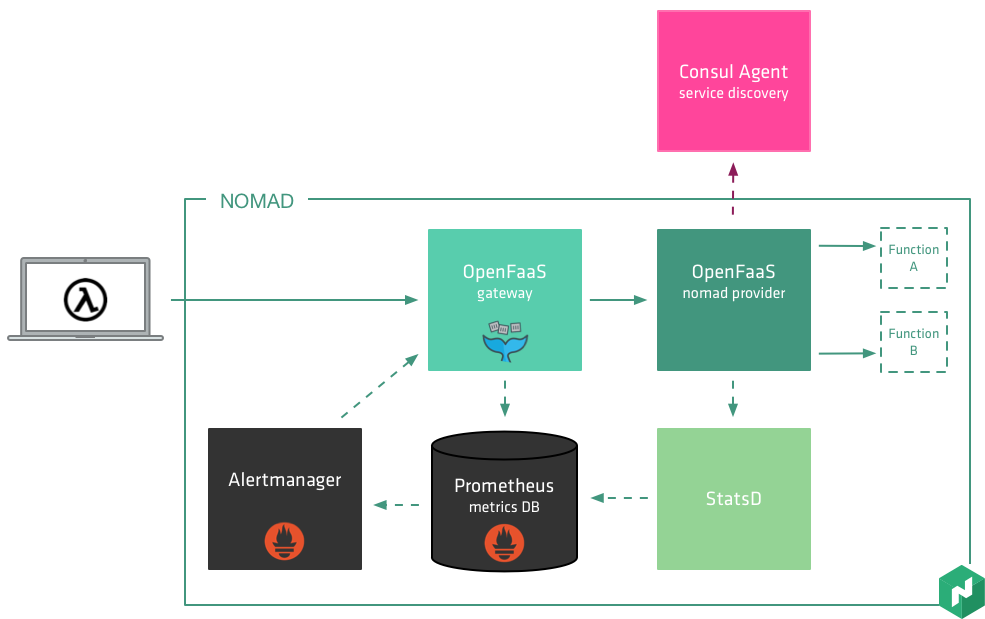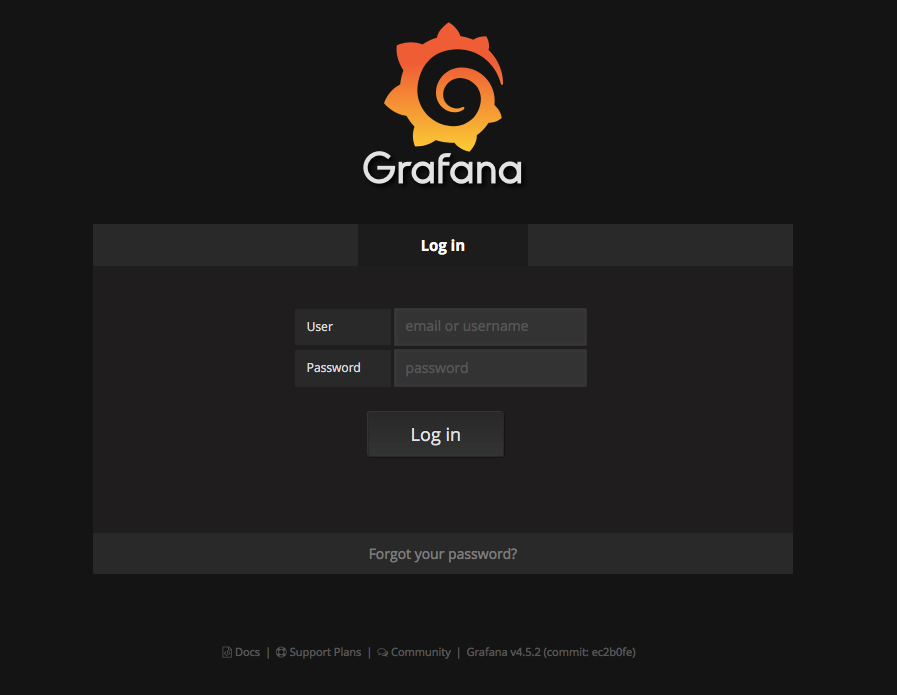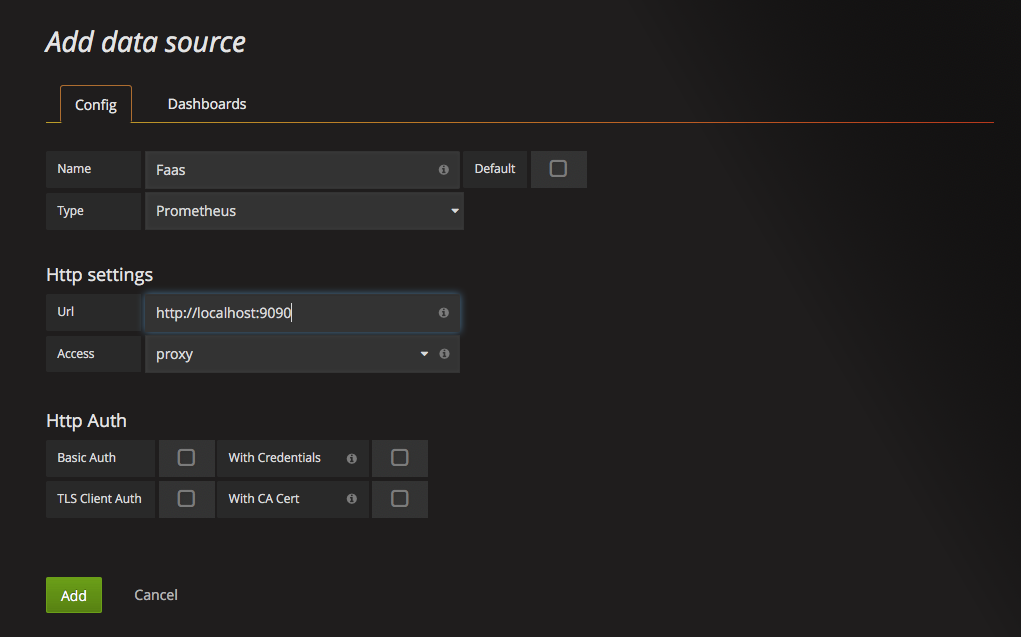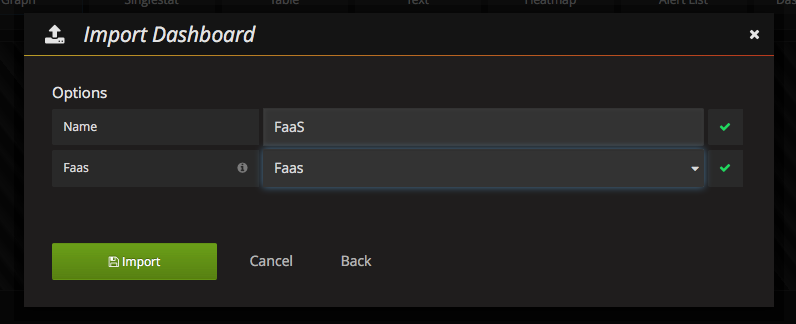hashicorp / Faas Nomad
Programming Languages
Labels
Projects that are alternatives of or similar to Faas Nomad
OpenFaaS - Nomad Provider
This repository contains the OpenFaaS provider for the Nomad scheduler. OpenFaaS allows you to run your private functions as a service. Functions are packaged in Docker Containers which enables you to work in any language and also interact with any software which can also be installed in the container.
OpenFaaS Architecture
For the simplest installation, only two containers need to run on the Nomad cluster:
- OpenFaaS Gateway
- OpenFaaS Nomad provider However for OpenFaaS to automatically scale your function based on inbound requests and to be able to gather metrics from the Nomad provider two additional containers are optionally run.
- Prometheus DB
- StatsD server for Prometheus
- Grafana for querying Prometheus data
OpenFaaS Gateway
The gateway provides a common API which is used by the command line of for deploying functions. In addition to this it also hosts a Prometheus metrics endpoint which is used to provide operational metrics. The gateway does not itself interact with the Nomad cluster instead it delegates all requests to the Nomad provider.
Nomad provider
The Nomad provider is responsible for performing any actions on the Nomad server such as deploying new functions or scaling functions. Also it also acts as a function proxy. Metrics such as execution duration and other information are emitted by the proxy and captured by the StatsD server. Prometheus regularly collects this information from the StatsD server and stores it as time series data.
OpenFaaS Functions
The functions performing the work on OpenFaaS are packaged as Docker images. When running on the cluster these functions do not provide any external interface; instead, interactions are performed through the Nomad provider. When a function is deployed, it is registered with Consul's service catalog. The provider uses this service catalog for service discovery to be able to locate and call the downstream function.
Starting a local Nomad / Consul environment
First, ensure that you have a recent version of Nomad and Consul installed, the latest versions can be found at:
Consul Versions | HashiCorp Releases
Nomad Versions | HashiCorp Releases
Make sure you download the correct architecture for your machine, binaries are available for most platforms, Mac, Windows, Linux, Arm, etc.
To get things up and running quickly you can run the bash script located in the root of this repository.
$ source ./startNomad.sh
Discovered IP Address: 192.168.1.113
Starting Consul, redirecting logs to /Users/nicj/log/consul.log
Starting Nomad, redirecting logs to /Users/nicj/log/nomad.log
NOMAD Running
The startup script will set the advertised address to your primary local IP address and run both Nomad and Consul in the background redirecting the logs to your home folder.
Using Vagrant for Local Development
Vagrant is a tool for provisioning dev environments. The Vagrantfile governs the Vagrant configuration:
- Install Vagrant via download links or package manager
- Install VirtualBox via download links or preferred hypervisor of your choice (vagrant plugins may be required). VMWare Fusion is supported.
-
vagrant up(default VirtualBox) orvagrant up --provider vmware_fusion
The provisioners install Docker, Nomad, Consul, and Vault (via Saltstack) then launch OpenFaaS components with Nomad. If successful, the following services will be available over the private network (192.168.50.2):
- Nomad (v0.8.4) 192.168.50.2:4646
- Consul (v1.2.0) 192.168.50.2:8500
- Vault (v0.9.6) 192.168.50.2:8200
- FaaS Gateway (0.9.14) 192.168.50.2:8080
This setup is intended to streamline local development of the faas-nomad provider with a more complete setup of the hashicorp ecosystem. Therefore, it is assumed that the faas-nomad source code is located on your workstation, and or is configured to listen on 0.0.0.0:8080 when debugging/running the Go process.
Starting a remote Nomad / Consul environment
If you would like to test OpenFaaS running on a cluster in AWS, a Terraform module and instructions can be found here: faas-nomad/terraform at master · hashicorp/faas-nomad · GitHub
Regardless of which method you use interacting with OpenFaaS is the same.
Running the OpenFaaS application
First, we need to start the OpenFaaS application, to do this there are two job files located in the folder nomad_job_files which set things up using sensible defaults.
To run the main application execute the following command:
$ nomad run ./nomad_job_files/faas.hcl
==> Monitoring evaluation "a3e54faa"
Evaluation triggered by job "faas-nomadd"
Allocation "28f60a54" created: node "867c6baa", group "faas-nomadd"
Allocation "7223b65d" created: node "d196a533", group "faas-nomadd"
Allocation "a4dbae6c" created: node "123e18c0", group "faas-nomadd"
Evaluation status changed: "pending" -> "complete"
==> Evaluation "a3e54faa" finished with status "complete"
This job will start an instance of the OpenFaaS gateway and the Nomad provider on every node in the cluster.
We can then launch the monitoring job to start Prometheus and Grafana:
$ nomad run ./nomad_job_files/monitoring.hcl
==> Monitoring evaluation "7d9c46df"
Evaluation triggered by job "faas-monitoring"
Allocation "e20ace08" created: node "123e18c0", group "faas-monitoring"
Evaluation status changed: "pending" -> "complete"
==> Evaluation "7d9c46df" finished with status "complete"
This job starts a single instance of Prometheus and Grafana on the Nomad cluster.
Setting up Grafana to view application metrics
If you are not using the provided Terraform module, you will need to locate the node which Grafana is running on, assuming you have not changed the job file the port will be 3000.
To log into Grafana use the default username and password admin.
Once you have successfully logged in, the next step is to create a data source for the Prometheus server.
Configure the options as shown ensuring that the URL points to the location of your Prometheus server. The next step is to add a dashboard to view the data from the OpenFaaS gateway and provider. A simple dash can be found at grafana\faas-dashboard.json, let's add this to Grafana. Clicking the Import button from the Dashboards menu will pop up a box like the one below. Choose the file for the example dashboard and press import.
Assuming all went well, you should now see the dashboard in Grafana:
Creating and deploying a function
To create functions, we can install the faas-cli tool, to get the CLI tool you can run the following command:
$ curl -sL https://cli.openfaas.com | sudo sh
Alternately if you are using a Mac, the cli is also available via brew install faas-cli
Creating a new function
Changing to a new folder we can create a new function by running the following command in the CLI:
$ faas-cli new gofunction -lang go
#...
2017/11/17 11:35:49 Cleaning up zip file...
Folder: gofunction created.
___ _____ ____
/ _ \ _ __ ___ _ __ | ___|_ _ __ _/ ___|
| | | | '_ \ / _ \ '_ \| |_ / _` |/ _` \___ \
| |_| | |_) | __/ | | | _| (_| | (_| |___) |
\___/| .__/ \___|_| |_|_| \__,_|\__,_|____/
|_|
Function created in folder: gofunction
Stack file written: gofunction.yml
The command will create two folders and one file in the current directory:
$ tree -L 1
.
├── gofunction
├── gofunction.yml
└── template
2 directories, 1 file
The gofunction folder is where the source code for your application will live by default there is the main entry point called handler.go:
package function
import (
"fmt"
)
// Handle a serverless request
func Handle(req []byte) string {
return fmt.Sprintf("Hello, Go. You said: %s", string(req))
}
The Handle method receives the payload sent by calling the function as a slice of bytes and expects any output to be returned as a string. For now, let's keep this function the same and run through the steps for building the function. The first thing we need to do is to edit the gofunction.yml. file and change the image name so that we can push this to a Docker repo that our Nomad cluster will be able to pull. Also, change the gateway address to the location of your OpenFaaS gateway. Changing the gateway in this file saves us providing the location as an alternate parameter.
provider:
name: faas
gateway: http://localhost:8080
functions:
gofunction:
lang: go
handler: ./gofunction
image: nicholasjackson/gofunction
Building our new function
Next step is to build the function; we can do this with the faas-cli build command:
$ faas-cli build -yaml gofunction.yml
#...
Step 16/17 : ENV fprocess "./handler"
---> Using cache
---> 5e39e4e30c60
Step 17/17 : CMD ./fwatchdog
---> Using cache
---> 2ae72de493b7
Successfully built 2ae72de493b7
Successfully tagged nicholasjackson/gofunction:latest
Image: gofunction built.
[0] < Builder done.
The build command execute the Docker build command with the correct Dockerfile for your language. All code is compiled inside of the container as a multi-stage build before being packaged into an Image.
Pushing the function to the Docker repository
We can either use the faas-cli push command to push this to a Docker repo, or we can manually push.
$ faas-cli push -yaml gofunction.yml
[0] > Pushing: gofunction.
The push refers to a repository [docker.io/nicholasjackson/gofunction]
cc9df684d32a: Pushed
4e12ae9c1d69: Pushed
cdcffb5144dd: Pushed
10d64a26ddb0: Pushed
dbbae7ea208f: Pushed
2aebd096e0e2: Pushed
latest: digest: sha256:57c0143772a1e6f585de019022203b8a9108c2df02ff54d610b7252ec4681886 size: 1574
[0] < Pushing done.
Deploying the function
To deploy the function we can again use the faas-cli tool to deploy the function to our Nomad cluster:
$ faas-cli deploy -yaml gofunction.yml
Deploying: gofunction.
Removing old function.
Deployed.
URL: http://192.168.1.113:8080/function/gofunction
200 OK
If you run the nomad status command, you will now see the additional job running on your Nomad cluster.
$ nomad status
ID Type Priority Status Submit Date
OpenFaaS-gofunction service 1 running 11/17/17 11:52:59 GMT
faas-monitoring service 50 running 11/15/17 14:43:11 GMT
faas-nomadd system 50 running 11/15/17 11:00:31 GMT
Running the function
To run the function, we can simply curl the OpenFaaS gateway and pass our payload as a string:
$ curl http://192.168.1.113:8080/function/gofunction -d 'Nic'
Hello, Go. You said: Nic
or you can use the cli
$ echo "Nic" | faas-cli --gateway http://192.168.1.113:8080/ invoke gofunction
That is all there is to it, checkout the OpenFaaS community page for some inspiration and other demos. faas/community.md at master · openfaas/faas · GitHub
Datacenters and Limits
By default, the Nomad provider will use the datacenter of the Nomad agent or dc1. This can be overridden by setting one or more constraints datacenter == value. Limits for CPU and memory can also be set memory is an integer representing Megabytes, cpu is an integer representing MHz of CPU where 1024 equals one core.
i.e.
$ faas-cli deploy --constraint 'datacenter == dc1' --constraint 'datacenter == dc2'
or from a stack file...
functions:
facedetect:
lang: go-opencv
handler: ./facedetect
image: nicholasjackson/func_facedetect
limits:
memory: 512
cpu: 1000
constraints:
"datacenter == test1"
Nomad Job Constraints
Additionally to the datacenter constraint Nomad job constraints are supported.
i.e.
$ faas-cli deploy --constraint '${attr.cpu.arch} = arm'
For compatibility and convenience the interpolation notation (${}) can be left out and == instead of = is supported.
All provided constraints are applied to the job (not the group or the task).
Leaving out the a field (.e.g. ${meta.foo} is_set) or using more than one operator (e.g. ${meta.foo} is_set = bar) is currently not supported.
Annotations
Metadata can be added to the Nomad job definition through the use of the OpenFaaS annotation config. The below example would add the key git to the Meta section of nomad job definition which can be accessed through the API.
functions:
facedetect:
lang: go-opencv
handler: ./facedetect
image: nicholasjackson/func_facedetect
annotations:
git: https://github.com/alexellis/super-pancake-fn.git
Secrets API
It is possible to integrate Vault secrets https://docs.openfaas.com/reference/secrets/ with the Nomad provider. Follow these steps to have OpenFaaS integrate with Nomad + Vault:
-
First, we need to enable the approle auth backend in Vault:
vault auth enable approle -
We also need to create a policy for faas-nomad and OpenFaaS functions:
vault policy write openfaas policy.hclPolicy file example: https://raw.githubusercontent.com/hashicorp/faas-nomad/master/provisioning/scripts/policy.hcl
It is important that the policy contain: create, update, delete and list capabilities that match your secret backend prefix. In this case, path
secret/openfaas/*will work with the default configuration.Also, faas-nomad takes care of renewing it's own auth token, so we need to make sure the policy uses path "auth/token/renew-self" and has the "update" capability.
-
Finally, let's setup the approle itself:
curl -i \ --header "X-Vault-Token: ${VAULT_TOKEN}" \ --request POST \ --data '{"policies": ["openfaas"], "period": "24h"}' \ https://${VAULT_HOST}/v1/auth/approle/role/openfaas
This creates the role attached to the policy we just created. The "period" property and duration is important for renewing long-running service Vault tokens.
curl -i \ --header "X-Vault-Token: ${VAULT_TOKEN}" \ https://${VAULT_HOST}/v1/auth/approle/role/openfaas/role-id
Produces the role_id needed for -vault_app_role_id cli argument.
curl -i \ --header "X-Vault-Token: ${VAULT_TOKEN}" \ --request POST \ https://VAULT_HOST}/v1/auth/approle/role/openfaas/secret-id
Produces the secret_id needed for -vault_app_secret_id cli argument.
Let's assume the Vault parameters have been populated, and you're now running faas-nomad along with the other OpenFaaS components. Now, try out the new faas-cli secret commands:
faas-cli secret create grafana_api_token --from-literal=foo --gateway ${FAAS_GATEWAY}
Now we can use our newly created secret "grafana_api_token" in a new function we want to deploy:
faas-cli deploy --image acornies/grafana-annotate --secret grafana_api_token --env grafana_url=http://grafana.service.consul:3000
Async functions
OpenFaaS has the capability to immediately return when you call a function and add the work to a nats streaming queue. To enable this feature in addition to the OpenFaaS gateway and Nomad provider you must run a nats streaming server.
To run the server please use the nats.hcl job file.
$ nomad run ./nomad_job_files/nats.hcl
You can then invoke a function using the async-function API, the call will be immediately retuned and OpenFaaS will queue your work for later execution.
curl -d '{...}' http://gateway:8080/async-function/{function_name}
Configuration and Function timeouts
By Default a function is allowed to run for 30s before it is terminated, should you require longer running functions timeout is configurable by setting the flag -function_timeout on the Nomad provider e.g:
args = [
"-nomad_region", "${NOMAD_REGION}",
"-nomad_addr", "${NOMAD_IP_http}:4646",
"-consul_addr", "${NOMAD_IP_http}:8500",
"-statsd_addr", "${NOMAD_ADDR_statsd_statsd}",
"-node_addr", "${NOMAD_IP_http}",
"-logger_format", "json",
"-logger_output", "/logs/nomadd.log"
"-function_timeout", "5m"
]
This would set the timeout to 5m for a function.
Contributing
The application including docker containers is built using goreleaser https://goreleaser.com.
Setup
- Clone this repo:
go get github.com/hashicorp/faas-nomad - Create a fork in your own github account
- Add a new git remote to $GOPATH/src/hashicorp/faas-nomad with your fork
git remote add fork [email protected]:/yourname/faas-nomad.git
Building the application
make build_all this runs the command goreleaser -snapshot -rm-dist -skip-validate
Testing the application
make test runs all unit tests in the application, for continuous test running try http://goconvey.co






